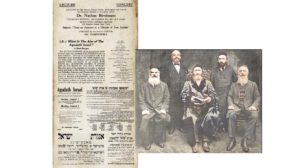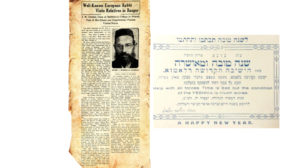Accepting the Divine Decree
| October 29, 2010For those of us who think we’re suffering when our morning plans don’t go as smoothly as we’d wish, it might be helpful to reflect on those whose suffering and isolation is beyond imagining
“They Were Always Happy”
H
is first visit to that sad place was on the happiest holiday of the year — Purim.
“A friend of mine, Yankele Levine, invited me to go with him to read Megillas Esther at the Hansen Lepers’ Hospital in Talbieh.” Rabbi Ephraim Holtzberg recalls. He is one of the first residents of Jerusalem’s Old City, and son of Rabbi Simchah Holtzberg, z”l, known as the Father of Israel’s Wounded Soldiers. “I went with him, and from then on, I went there every Erev Shabbos with my friends. People were afraid to visit them. The image of people hospitalized in a lepers’ hospital frightened even close family members.”
He remembers the blind Arab patient who always sat and wept, bemoaning his bitter fate. One of the nurses told Rabbi Ephraim that no one ever visited this man. His family told him, “If you pay us, we’ll visit you,” and that broke his heart.
“The germ is highly contagious,” Rabbi Ephraim explains. “So there were stringent precautions, and the staff dining hall was separate from the patients’ dining hall.”
Once, when Holtzberg was touring the beautiful grounds of the hospital, a nurse pointed out to him an unmarked burial plot containing the graves of five lepers. They had been buried wrapped in whitewashed sheets, because people were afraid to perform the purification (taharah) that is normally administered to the dead.
One of the nurses, Naomi, had contracted leprosy in her youth, but had recovered. The patients saw her as one of them, for she understood their hearts, and she, too, used to eat with them in their dining hall. Other than that, they were alone.
“But I would bring food and sit and eat with them, “ says Rabbi Ephraim. “I took along little disposable trays of schwarma and french fries, or sometimes cholent and fried chicken. I would prepare something to say about the parshah of the week, and I used to go there, dance with the patients, sing with them. They waited for me every week in the hospital dining hall. I shook hands with them.
“I wasn’t afraid. Because, after all, ‘Mitzvah-emissaries are not harmed.’”$$$separate quotes$$$
Ever since that first Purim, and over many years, Rabbi Ephraim Holtzberg visited the lepers faithfully. After Hansen Lepers’ Hospital was closed and the patients were transferred, with medicine to prevent contagion, to the Neve Simchah retirement home, he continued to visit with them there. He was at their side until their last day. He discovered among them great souls, who reached spiritual heights that most people could not achieve ...
Reb Moshe’s Story
“Mommy! Daddy! I want to come home!”
“No, Moshie!” his father said. “You can’t come into the house! You’ll infect all your brothers and sisters! We have to take you back there!” Then he took his son back to the hospital, and the family moved to a hidden location so that Moshie would not again climb over the high stone wall of the institution and try to return home. Moshie was eight years old. He never saw his family again.
In those days, a British sentry guarded the place. No one was allowed in or out. The British nurses were afraid to go near the patients. So, they would tie an apron onto Moshie, and several times a day, they would toss into it a tomato, a slice of bread, and an egg. The little boy’s heart was terribly homesick. He drew pictures, and in his pictures — even those drawn in his later years — one could see clearly the pain of a child who longed for his parents. The nurses told of the night he woke up with his frightened cries. They hurried toward him, and he told them that he had dreamed that his father had passed away — and indeed, a few days later, a telegram came, informing them of his father’s death. Two years later, the same scene was repeated. This time, Moshie dreamed that his mother had passed away. And again, a few days later, a telegram informed them of his mother’s death.
When Rabbi Ephraim Holtzberg met him, Reb Moshe was close to eighty years old. “Fortunately for Moshe,” Rabbi Ephraim relates, “he never went to school; they never taught him that he was supposed to be sad. He was always happy. He had an accordion and a harmonica, and he would play music, and sing. One of the effects of the disease is a loss of sensation in the extremities. (The hot water urn in the hospital was wrapped in a heat-proof material so the patients wouldn’t be burned without feeling it.) After his leg was amputated and he was confined to a wheelchair, he asked me to bring him many pairs of shoelaces with which he tied up his stump.
“Once, he asked me to bring him water from the Garden of Eden. It took me a while to realize that he meant the Mei Eden brand of mineral water. Rabbi Aharon Bina, today Rosh Yeshivah of Netiv Aryeh, donated a Mei Eden water cooler which provided both hot and cold water, along with an unlimited supply of bottled mineral water.”
The lepers lived their entire lives in isolation and suffering. At the Neve Simcha retirement home, the nurses were aware of this, and worked with great self-sacrifice on their behalf. One of them, a convert who had come on aliyah from Russia, told Rabbi Ephraim that she once scolded Moshe. “There are fifty patients on this floor!” she told him. “But you, one person, drive us nurses crazy, like all fifty together! Enough already!” That same night, she dreamed that she was standing before the Heavenly Court. “Know that Moshe’s suffering equals that of all the other patients together,” they told her. “Do not scold him again.” She woke up trembling, and ran to ask his forgiveness.
Moshe waited for Rabbi Ephraim Holtzberg every Friday, looking all around and asking, “Where’s Holtzberg? Where’s Holtzberg?” That was his life, until he went on to the Next World. When Rabbi Ephraim was informed by telephone that Moshe had passed away, he asked the chevra kadisha to open the eulogy hall of the Sanhedria Funeral Home so that he could deliver a hesped. They told him, “There’s no need to open the hall. There’s barely a minyan at the funeral.” So Rabbi Ephraim delivered the eulogy standing beside the blue hearse. “That was during a terrible period of terror attacks,” he recalls. “I said, ‘Ribono shel Olam! This man lived his whole life, from age eight, in the lepers’ hospital! He had no bar mitzvah, no wedding, no children! At the end of his life, he didn’t even have legs! But he was always happy, always playing music! He never complained! I am asking You, Ribono shel Olam, that in his merit, the terror attacks should stop!’”$$$separate quotes$$$
Margalit’s Story
Rabbi Ephraim Holtzberg will never forget Margalit the Tzaddeikes.
She came on aliyah as a sixteen-year-old orphan girl from Yemen, during Operation Magic Carpet (1949–50), walking off the plane clutching a small sefer Torah that had been handed down in her family through the generations. But the sefer Torah was taken away from her “for safekeeping,” and she was taken for a medical examination.
The doctors erroneously diagnosed Margalit as infected with leprosy, and sent her to the Hansen Lepers’ Hospital. When they realized their mistake and were ready to release her, they discovered that she had meanwhile become infected with the disease. She reconciled herself to her bitter fate, accepting that she would never marry, never hold a child in her arms. “What astounded me during all the years I visited that place,” Rabbi Ephraim explains, his eyes glistening, “was how everyone there accepted the Divine decree with love.”
Rabbi Aryeh Levine, ztz”l, the Jerusalem Tzaddik, was for many years the only one who dared visit these patients. He came once a week to give the patients some moments of consolation. And he came to daven with them every Rosh HaShanah, together with his two sons, who would blow the shofar.
“A few years ago, when I brought Rabbi Aryeh Levine’s son, Rabbi Raphael Levine, ztz”l, to the hospital for a visit, Margalit gazed first at the picture of Rabbi Aryeh Levine which hung on the wall in the patients’ dining hall, and then at the face of his son, Rabbi Raphael. She contemplated the countenance in the picture, glowing with love, and then the so-similar glowing face of Rabbi Raphael, and tears flowed from her eyes as well as from the eyes of the other veteran patients.”
Margalit saved up pennies from her government allowance and finally succeeded in finding a Yemenite scribe who would write a sefer Torah for her. The Torah scroll was inaugurated with honor in a trailer-synagogue in Kiryat Arba. But in this too Margalit’s fate was harsh. A fire broke out in the trailer, and the Torah scroll went up in flames, its letters flying Heavenwards.
Margalit grieved. After the fire, her medical condition worsened. Besides the leprosy, which afflicted her severely, affecting her fingers and toes, a tumor was discovered in her brain. Immediately on being informed of this, Margalit decided to have a second sefer Torah written. It would be like her child. She applied to Bituach Leumi, Social Security, for a loan. “How will you repay it?” they asked. She answered: “Put a lien on all my income from my government allowance for the rest of my life!” Thus the second Torah scroll was written. It was inaugurated in the synagogue of a settlement near Jerusalem, and Margalit’s heart rejoiced.
“When I visited Margalit the Tzaddeikes, as usual, one Erev Shabbos, I witnessed a dialogue between her and a non-religious nurse. ‘Margalusha!’ exclaimed the nurse. ‘What a mistake you made to give up all your money for a Torah scroll! Now it’s almost Shabbat, and you’re wearing torn stockings! And you don’t have money to buy new ones!’ Margalit answered without hesitation: ‘But you know that I am childless. What do you want me to leave behind — a beautiful pair of stockings? I am leaving behind a sefer Torah. That is my children!’ The nurse, moved by this answer, immediately ran and, with her own money, bought Margalit a new pair of stockings for Shabbos.
“A few years ago, during a Shalosh Seudos in the presence of Maran Rav Elyashiv, shlita, I told him about Margalit and her Torah scrolls. In my enthusiasm, I took the liberty of saying: ‘Just as there is a concept of chassan Torah, the Bridegroom of the Torah, Margalit is kallas HaTorah, Bride of the Torah!’ The Rav nodded in agreement.”
Margalit, too, was eventually transferred to the Neve Simchah home. There, after a severe stroke, she lay in a coma for two years, fed through a stomach tube. Rabbi Ephraim says, “Then I understood the significance of the praise which we recite in Bircas HaMazon — where we do not simply thank Hashem ‘for the food’ (al hamazon), but ‘for the eating of the food’ (al achilas mazon).”
Rabbi Ephraim can’t help weaving in some humor to brighten the tragedy of the story. “During her last year, as Margalit lay unconscious at Neve Simcha, I visited her as usual, every Erev Shabbos. I used to ask the nurses, ‘How is my Aunt Margalit?’ They would look back and forth between the two of us, trying to figure out the family connection. After all, Margalit was clearly Yemenite, and I looked completely Ashkenazic. ‘When I was little,’ I explained to the nurses, gravely, ‘I slipped and fell into a bucket of bleach, and from then on, I lost my healthy brown Yemenite complexion and was left as pale as you see me now.’ The nurses’ eyes widened. ‘Really?’ they exclaimed. ‘You don’t say!’”$$$separate quotes$$$
Due to an infection, Margalit was hospitalized in Shaare Zedek for several weeks; her condition deteriorated. One Motzaei Shabbos, a short telephone message conveyed to Rabbi Ephraim that the time had come to recite the blessing, Baruch Dayan HaEmes. Margalit the Tzaddeikes had returned her soul to her Creator on Shabbos, the sixth of Adar; burial was that night, on the seventh of Adar, the yahrtzeit of Moshe Rabbeinu.
“Since Margalit had no family, I was afraid I wouldn’t be able to gather a minyan for her levayah. So I asked that the funeral be announced by loudspeaker, as a meis mitzvah, a person who has no one to attend his or her funeral. I hoped that in this way, people would attend.
“The cry of Kletzkin’s loudspeaker-van tore through the air in the streets of Geula, Meah Shearim, and Zichron Moshe. It blared out: ‘The funeral of a meis mitzvah, Margalit Gamliel bas Avraham, will begin at ten-thirty tonight, from the funeral home to Har HaMenuchos. The funeral of a meis mitzvah!’ Who responded? Only three tzaddikim, Gerrer chassidim, came to the funeral home, still in their shining Shabbos garb. They stayed to the end, until the gravestone was in place.
“The men of the chevra kadisha asked me to say a hesped. I stood up, filled with emotion, and said: ‘Creator of the Universe! The Tzaddeikes Margalit never complained to You about her bitter fate. She accepted Your judgment with love. So likewise You, Creator of the Universe, in the merit of Margalit, whose saga of suffering has ended — do not bring charges against Your children! By her terrible suffering, she undoubtedly shielded our generation. Now You proclaim an end to our sorrows!”
Margalit was accompanied to Heaven by passages of mishnayos, recited by those who read the printed request distributed in synagogues throughout Jerusalem, requesting Mishnah-study “for the elevation of the soul of the meis mitzvah, Margalit bas Avraham, of the Gamliel family.”
Memories of those suffering patients accompanies Rabbi Ephraim to this day. He remembers Avraham, another Yemenite patient, who loved to study Zohar. It was one of his few pleasures in this world. When his sight began to fail, Avraham asked Rabbi Raphael Levine to bless him that he would retain his vision so that he could continue to learn Zohar.
If there is a message that Rabbi Ephraim Holtzberg draws from his experiences in that sad place, it is the message of simchah, joy. “The patients there were at the lowest of the low places that a person could be. They were in pain, suffering, alone, broken, outcast. But they never complained. I never heard a word of complaint from their mouths. They accepted the Divine judgment with love.
“They were always b’simchah.”
IS LEPROSY THE SAME AS TZARAAS?
H
istorically, individuals with Hansen's disease have been known as lepers, however, this term is falling into disuse as a result of the diminishing number of leprosy patients and the pejorative connotations of the term. The term most widely accepted among people and agencies working in the field of Hansen's disease is "people affected by Hansen's disease."
Mycobacterium leprae, the causative agent of leprosy, was discovered by H. Armauer Hansen in Norway in 1873, making it the first bacterium to be identified as causing disease in humans.
The term tzaraas from the Tanach was, erroneously, commonly translated as leprosy, although the symptoms of tzaraas were not entirely consistent with leprosy and rather referred to a variety of disorders other than Hansen's disease.
The clinical symptoms of leprosy vary but primarily affect the skin and the nerves.
THE LEPER’S HOSPITAL
T
he Hansen Government Hospital for Lepers, also known as the "Lepers' Hospice," was constructed in 1887 and designed by Conrad Schick, a leading German architect and theologian, and is located on Marcus Street in the Talbieh neighborhood. It is considered one of the most beautiful buildings in the capital.
At present, the Hansen Hospital (named for Henrik Armauer Hansen, the Norwegian physician who discovered the leprosy bacillus) serves as a clinic for treating the disease, but is not operative for the most part.
THE MYSTERY OF THE RED ARMCHAIR
I
t turns out that the armchair belonged to Dr. Moshe Goldberger and his wife Devora, who have been living in the compound since 1964. The doctor, who is 92 years old, returned to Israel with his family from the United States in 1964, and began to work at Hadassah University Hospital in Ein Karem. Later on he joined a research group that worked in the Hansen hospital, and served as an in-house doctor for the institution. The compound included a neglected house that was supposed to be the guard's residence, and in the 1950s it was occupied by the director of the Health Ministry. When the building became available, the doctor, his wife and their daughter Rivka (today Regev) moved into it. Regev, who was 14 and a half years old at the time, remembers how "strange and interesting" it was to live in that house, which few of her friends dared to visit. Her father became so attached to the patients, she says, that he continued to work as a volunteer there until the age of 85, and did a great deal to preserve the beautiful garden. "It was about six dunams [1.5 acres] of a wonderful, primeval paradise inside Jerusalem," she says.
(Originally featured in Mishpacha Issue 231)
Oops! We could not locate your form.












